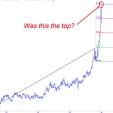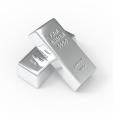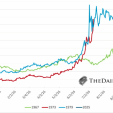Silver: A Forgotten Commodity?
 What was once the darling of yesterday, the “poor man’s gold” is now a forgotten commodity. Although similar to gold, you do not hear any experts discussing silver purchases!
What was once the darling of yesterday, the “poor man’s gold” is now a forgotten commodity. Although similar to gold, you do not hear any experts discussing silver purchases!
Bottoms are formed when market participants have little, or no interest, in a commodity. Buying silver as a long-term investment asset could provide better returns compared to gold in the long run.
The chart below displays why silver is a neglected asset. Since the beginning of the year, gold has returned handsome gains for its investors. However, during this same period of time, the returns from silver have been lackluster, as indicated in the chart below.

Historical Significance Of Silver
Historically, if you go back further in time, you have silver being a prominent 'medium of exchange’. It is easy to make transactions in terms of silver coins, because of their relatively lesser value as compared to gold. Therefore, I believe that this type of money that will exist in everyday transactions. In fact, some new services allow us to pay with gold or silver on thousands of websites already which is proof it works, and there is demand for this type of payment processing.
This white metal has been used for thousands of years, as a precious metal. The first use of silver coins dates back as early as 600 BC. All of the famous currencies of their time, i.e.: the Drachma of the ancient Greeks, to the Roman Denarius and the British Pound Sterling were all based on a designated weight of silver.
It is only recently that the coins were shifted from silver to other less expensive alloys.
Silver coins in Europe were in circulation before the historical period of Alexander the Great; the use of silver in Europe and thereafter in the Americas, continued until the 1960’s.
Uses Of Gold And Silver
Although precious metals are used to make jewelry and other artifacts with the progress in electronics and digitalization, silver has been found to be used extensively within industries. Most of the silver that has been used is not recoverable, unlike that of gold (where it is presumed that 95% of every ounce of gold, that was ever mined, is still available in one form another or another). However, the same is not true of silver, due to its growing industrial use.
Supply And Demand Of Silver
The supply and demand of any asset class determine its long-term price. The table below gives an indication of the supply deficit in silver during the past decade. Barring 2014, demand for silver has always exceeded its supply.
Although the supply of silver has increased during the decade, the demand for the ‘white metal’ has also increased, equally.

The Gold To Silver Ratio
Although gold has always commanded a higher value, as compared to silver, an appropriate approach to evaluate both is by the ratio between both of these precious metals.
The silver/gold ratio by global deposits is 18.75; that is, for every troy ounce (oz.) of gold, you can find 18.75/ oz. of silver in the earth’ crust. However, the price ratio of the precious metals, respective to one another, has varied depending upon the availability of both gold and silver and their respective demand.
The great Sir Isacc Newton also fixed the ratio of gold/silver at 1:15.5 while he was the master of the Royal Mint, in 1717. The chart below shows the gold/silver ratio during different periods of time.
Therefore, a current study of the gold/silver ratio charts will give us a clear understanding of the potential of both of these precious metals, respectively.
The chart below indicates that during the last three times that the ratio between the two metals had closer to 80 levels, it had ‘tipped’ over. This means that even if the price of gold remains where it is, silver will rise in order to correct the ratio. Hence, the profit potential is currently more in silver as opposed to gold.
Imagine if the ratio comes down to its actual historical average of 1:16. If gold prices remain where they are at $1200/oz., silver will quote at a price of $75/oz. If we consider, conservatively speaking, that every time that the ratio peaks around the 80 levels, it drops down to the levels of 40. At this current rate, if gold remains at $1200/oz., silver should quote at $30/oz.

Silver has been reluctantly sluggish in its participation in the early part of 2016’s powerful gold rally, which has been glaringly obvious! Instead of amplifying the yellow metals’ big movement, as in the past, silver largely failed to keep pace. The lack of silver’s confirmation for gold’s big move has certainly raised concerns. This happened back in 2009-2010: gold broke out and rallied, and it took silver almost a year longer to truly breakout and start its massive run higher. I think this could happen again.
Silver has always been something of an investment ‘enigma’, somehow, combining attributes of a highly-speculative investment, a conventional industrial commodity and an alternative currency. Silver tends to trend sideways, boringly for long periods of time…and then skyrockets higher into bullish markets that they are celebrated for years to come, much like the real estate market.
Silver’s driver has always been the price of gold. While silver can ‘decouple’, over the short-term, these two precious metals have very high correlations across most multi-year spans. This is the result of silver’s unique supply and demand profile. Silver’s industrial demand, including all fabrication and jewelry and silverware accounts for around 4/5’s of its’ total global demand. This tends to be fairly constant over time.
Silver effectively acts like a gold sentiment gauge, mirroring gold’s action.
When gold is climbing decisively and investors believe its rally is sustainable, they tend to flock back to silver. Silver is such a tiny market in ‘capital terms’, relatively small inflows can drive utterly massive price surges.

Conclusion
I believe that as we reform the monetary system, there will be an increase in the demand for silver relative to the increase in the demand for gold. Gold is an ‘establishment’ metal relative to silver. There are no central bank ‘hoarders’ of silver, anywhere or anymore. There is no one in the ‘establishment’ who considers silver as money (as of yet), other than JP Morgan of course.
My readers are well aware that I am extremely bullish on gold for the long-term. During the next crisis, gold and silver are the metals which will offer ‘stellar’ returns. However, at different times during the next few years, each metal will offer an excellent opportunity to earn handsome financial returns -- and they could be at different times.
I will be recommending to buy gold, whereas at other times, I will recommend buying silver. The final goal is to ‘maximize’ returns for my readers.
********


















